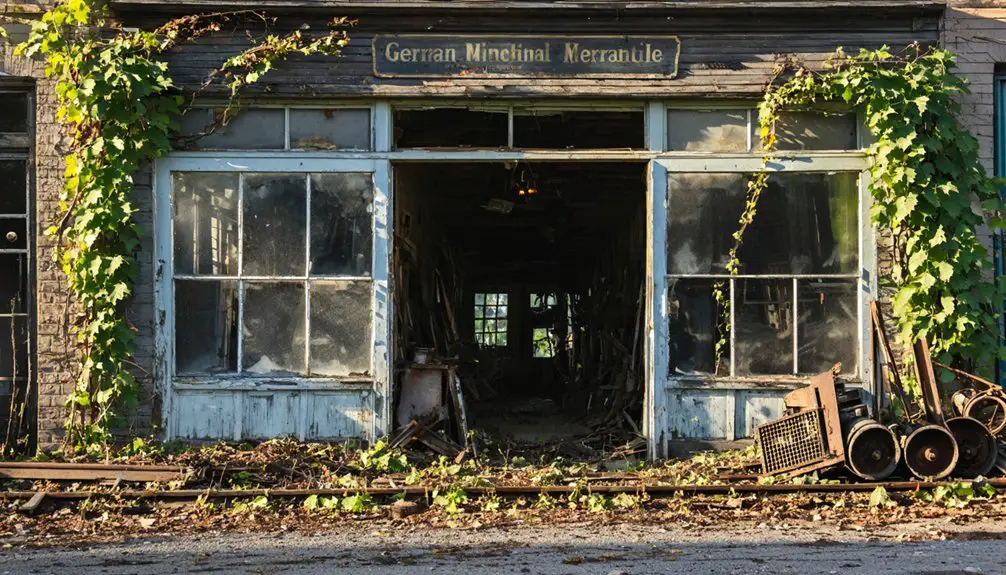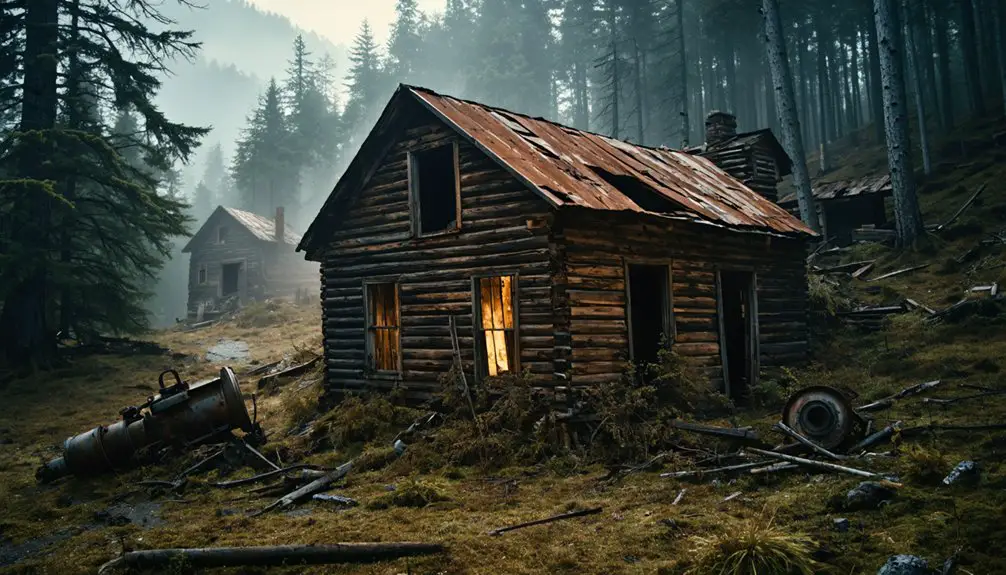You’ll find the ghost town of Altamont, Maryland perched at 2,628 feet in the Allegheny Mountains, where it once thrived as a bustling railroad and industrial hub. German, Lithuanian, and Eastern European immigrants built this diverse community around textile mills and the Baltimore & Ohio Railroad. After Daniels Mill closed in 1968, forcing out 279 residents, Tropical Storm Agnes delivered the final blow in 1972. Today, only church ruins and scattered foundations hint at deeper stories of this abandoned mountain town.
Key Takeaways
- Altamont was a thriving railroad and industrial town that became abandoned after the closure of Daniels Mill in 1968.
- The town’s decline accelerated when over half of its 279 residents relocated due to company-ordered housing demolitions.
- Tropical Storm Agnes in 1972 caused devastating damage to remaining structures, preventing any chance of community revival.
- Two partial church structures remain as the main visible remnants of this once-bustling industrial community.
- The town’s location at 2,628 feet marked the highest point of the Baltimore & Ohio Railroad line in Maryland.
Origins and Early Settlement
While indigenous peoples originally inhabited the mountainous terrain of what would become Altamont, Maryland, European settlement didn’t begin until the 18th and early 19th centuries.
You’ll find that Anglo-Saxon and German immigrants were among the first to establish roots here, creating small farming communities in Garrett County’s rugged landscape. These settlers brought with them German folklore stories that would become part of the region’s supernatural heritage.
Settlement patterns evolved as newcomers adapted to the challenging Appalachian environment, where they relied on hunting, trapping, and subsistence farming. The area’s natural resources, including timber and freshwater streams, proved essential for survival. Like many mining boom towns of the era, Altamont experienced rapid growth during the 1880s.
Early settlers adapted to harsh mountain life through hunting and farming, while timber and streams sustained their growing communities.
As Lithuanian, Italian, and Eastern European immigrants arrived later, they formed distinct cultural influences that shaped the community’s identity. Churches, schools, and general stores emerged as social hubs, while one-room schoolhouses educated the settlement’s children, creating a tight-knit mountain community.
Industrial Development and Economic Peak
You’ll find Altamont’s industrial transformation began when it emerged as an essential railroad hub in Western Maryland, connecting the region’s iron production and milling operations to broader markets.
The town’s strategic location along transportation routes helped local mills expand their production capabilities, particularly in grain processing and iron manufacturing.
Your journey through Altamont’s peak period would reveal a bustling economy driven by diverse industrial operations, including iron forges, grist mills, and supporting businesses that employed both local and immigrant workers.
Railroad Hub Transforms Town
The strategic placement of Altamont along the Baltimore and Ohio Railroad’s main stem transformed this Maryland mountain town into a significant transportation hub during the mid-19th century.
Perched at 2,628 feet, you’d find yourself at the highest point of the B&O line in Maryland, where a challenging 17-mile ascent up Backbone Mountain tested the limits of railroad expansion.
The railroad’s construction demanded extensive engineering, with workers blasting through rock and building bridges to conquer the Allegheny Mountains.
You could watch as trains carried lumber, coal, and agricultural products between Baltimore and the Ohio River, connecting rural mountain communities to major markets.
Local businesses flourished as Altamont became part of an essential industrial network stretching from Maryland to Chicago.
The Western Maryland Railway expanded its regional reach through the area when they completed the Connellsville Extension in 1912.
The railroad’s fleet included over 10,000 cars for transporting various types of freight across the region.
Mill Operations Drive Growth
As Altamont’s industrial landscape began taking shape in the early 19th century, grain mills emerged as the town’s economic cornerstone. You’d have seen water-powered mills dotting the local streams and creeks, converting the region’s wheat, rye, and corn into flour and meal. These operations fostered economic interdependence between farmers, millers, and merchants in surrounding communities.
Mill innovations transformed the town’s capabilities, as operations expanded from basic grain processing to include textile production. You’d have witnessed the rise of cotton mills equipped with spindles and hand looms, while ancillary businesses like distilleries and breweries flourished nearby. The scale of production rivaled that of Bethlehem Steel’s operations, though on a smaller industrial footprint. The mills relied heavily on enslaved workers’ labor, similar to Maryland’s iron furnaces of the period.
The mills’ success attracted financial backing from New York investors, leading to increased capitalization and market expansion, though some operators maintained their independence through electrification and modernization efforts.
Daily Life in Historic Altamont
If you lived in historic Altamont, your daily routine would’ve centered around the textile mill’s shifts, with family members working long hours while children attended the company-run school.
Your modest 4-6 room company house, complete with front yard and back garden, provided a comfortable if simple home base within walking distance of essential amenities.
You’d spend your leisure time at community gathering spots like the general store, bowling alley, pool hall, or church, where you’d socialize with fellow mill workers and their families. These stories and experiences became part of the town’s rich oral history tradition, passed down through generations of residents. The town remained active until Hurricane Agnes devastated the area, forcing residents to permanently abandon their homes.
Work and Family Routines
Daily life in historic Altamont revolved around the rhythms of coal mining and railroad operations, with families adapting their routines to match industrial schedules.
You’d find clear labor divisions, where men worked long shifts in the mines or maintained railroad tracks, while women managed households and small farms.
Like the early settlers of Delaware, residents relied on trade and commerce to sustain their community through exchanging goods and services with neighboring towns.
Children pitched in with household chores from an early age, balancing school attendance with family duties.
Your daily survival depended on self-sufficiency. You’d spend time raising livestock, preserving food, and gathering firewood.
The seasons dictated your routines – winters meant increased coal mining activity, while summers brought intensive agricultural work.
Train schedules structured your social life and business dealings, with postal deliveries connecting you to the outside world through rural delivery routes.
Similar to Burkettville’s early days, the community supported various local businesses including a schoolhouse and blacksmith that served as essential pillars of daily life.
Community Gathering Places
Beyond the daily work routines, Altamont’s social fabric centered around its churches and communal spaces.
Two partial churches and one abandoned church structure served as the town’s primary gathering spots, hosting weekly services and community events. You’d find residents congregating for both spiritual worship and social gatherings, with the churches doubling as venues for town meetings and cultural exchanges.
The town’s commercial areas, including mills and local shops, provided additional spaces where you could trade goods and catch up with neighbors.
Near the creek and dam, you’d spot locals fishing or washing while socializing.
The cemeteries, particularly one containing a burial from 1917, became sacred grounds where the community gathered to honor their deceased and maintain connections to their shared past.
Housing and Living Conditions
Throughout Altamont’s industrial heyday, you’d find workers living in modest wooden frame houses owned and rented out by the mill operator and later the C.R. Daniels Company. These basic dwellings often lacked modern conveniences like indoor plumbing and heating, reflecting the era’s working-class standards.
Housing challenges intensified as the buildings aged, with limited maintenance leading to deteriorating living conditions by the 1940s. You’d have relied on company-owned amenities for most daily needs, with few private enterprises available in town.
When the mill announced its closure in 1968, you’d have faced a dire situation – nearly half the population had to relocate due to lost jobs and housing. The final blow came in 1972 when Tropical Storm Agnes destroyed many remaining structures.
The Role of Immigration and Cultural Heritage

While Baltimore served as America’s second-largest immigrant gateway after Ellis Island, the surrounding regions, including Altamont, were profoundly shaped by waves of European immigration in the 19th century.
Germans formed the largest immigrant group, fleeing military conscription during the Napoleonic Wars and later, the 1848 revolutions. They established thriving communities that influenced the region’s development through banks, newspapers, and cultural institutions.
You’ll find that immigrant heritage defined Altamont’s character, as German settlers joined other European groups like Poles, Bohemians, and Irish in western Maryland.
These newcomers brought essential skills to the area’s railroad, coal, and mining industries while maintaining their traditions through cultural festivals, religious observances, and social clubs that enriched the region’s identity.
Railroad Connection and Transportation Hub
You’ll find the remnants of Altamont’s once-bustling rail infrastructure at its 2,628-foot summit, where the Baltimore & Ohio Railroad conquered the steepest grade in Maryland.
Between 1880 and 1920, Altamont reached its zenith as a strategic transportation hub, managing both eastbound and westbound traffic along the essential mountain passage.
The town’s freight loading station played a significant role in the region’s economic growth, facilitating the movement of coal, raw materials, and finished goods between the Eastern Seaboard and Midwest markets.
Rail Infrastructure Remains Today
Located at the summit of the Baltimore & Ohio Railroad‘s Main Stem at 2,628 feet elevation, Altamont served as an essential transportation hub connecting Western Maryland to broader markets in the mid-19th century.
The B&O’s rail connectivity through Altamont enabled the movement of coal, timber, and freight from Western Maryland and West Virginia to Mid-Atlantic and Midwestern destinations.
Today, you’ll find limited infrastructure preservation around Altamont. While the original railbeds and right-of-way alignments remain visible, most of the railroad yards and maintenance shops have disappeared.
The heavily engineered infrastructure built to handle the steep 2.2% grade – including cuttings and trestles – can still be traced in the landscape.
Though rails and equipment are largely gone, some segments of the historic rail system survive as heritage railways or recreational trails.
Peak Transportation Operations 1880-1920
During its peak operations from 1880 to 1920, Altamont served as an essential railroad hub where the Baltimore & Ohio‘s main line conquered its highest Maryland elevation at 2,628 feet.
You’d have witnessed groundbreaking transportation innovations as trains tackled the challenging 2.2 percent grade up Backbone Mountain, pushing the limits of rail engineering.
The economic impacts rippled through the region as B&O’s mainline connected Baltimore to the Ohio River and Chicago, while the Western Maryland Railway’s expansion after 1900 created significant interchanges for moving coal and timber.
You could’ve watched freight trains hauling Appalachian resources and agricultural products downhill toward urban markets, while passenger services transported workers and residents along the mountain corridor.
During World War I, Altamont’s strategic position made it indispensable for wartime logistics.
Freight Loading Station History
As the Baltimore & Ohio Railroad carved its way through the Allegheny Mountains, Altamont emerged as an essential freight loading station at the line’s highest Maryland elevation of 2,628 feet. The town’s strategic location atop a challenging 2.2% grade made it vital for freight logistics throughout the region.
After 1863, you’d find a bustling depot handling both passenger service and cargo transport. The station’s freight platforms and sidings efficiently managed coal shipments and other bulk materials from local industries.
Through connections with the Western Maryland Railway and other lines, Altamont’s freight operations linked the resource-rich Alleghenies to markets stretching from the Mid-Atlantic to the Ohio River Valley. The station’s extensive infrastructure, including loading platforms and rail yards, supported the area’s thriving coal and lumber industries until newer transportation modes emerged after 1918.
The Decline Years: From Prosperity to Abandonment
The unexpected closure of Daniels Mill in 1968 marked the beginning of Altamont’s rapid decline from a thriving industrial community to an abandoned ghost town. The company’s decision, driven by economic motivations, triggered an immediate exodus of over half the town’s 279 residents.
You would’ve witnessed the community disintegration unfold as the Daniels Company, which owned most structures, announced plans to demolish all housing without public explanation.
The remaining residents faced forced relocation as services were withdrawn and buildings demolished. By the early 1970s, with no replacement industries to sustain the population, most inhabitants had departed.
The final blow came when Tropical Storm Agnes struck in 1972, severely damaging the remaining structures and eliminating any chance of revitalization.
Today, you’ll find only ruins accessible by hiking trails within Patapsco River Valley State Park.
Natural Disasters and Structural Collapse
While Daniels Mill’s closure triggered Altamont’s initial decline, natural disasters delivered the final, devastating blows to this once-thriving Maryland town.
You’ll find evidence of nature’s destructive power in the ruins, where Tropical Storm Agnes‘s 1972 floods ravaged the area’s remaining structures and displaced vehicles throughout the site. The town’s position along the Patapsco River left it particularly vulnerable to repeated flooding, which steadily eroded building foundations and weakened structural integrity over time.
Fire added to the destruction, especially in 1926 when lightning struck the Gothic Saint Stanislaw Kostka church.
The combination of floods, fires, and Maryland’s harsh Appalachian weather patterns proved too much for the abandoned buildings, leading to progressive collapse and leaving only stone facades among the rubble.
Remaining Structures and Archaeological Findings
Standing amid dense forest overgrowth, two partial church structures remain as the most prominent monuments to Altamont’s existence.
You’ll find scattered ruins exploration opportunities among the foundations of former homes and abandoned vehicles that tell the story of the town’s sudden desertion after Tropical Storm Agnes in 1972.
The site’s archaeological significance lies in its industrial heritage, with ruined textile mills and manufacturing debris along the riverbanks.
You can discover masonry foundations, broken mill gears, and weathered gravestones in overgrown cemeteries.
While household artifacts occasionally surface, most have been lost to storm damage and decades of decay.
The floodplain location that once powered the mills ultimately contributed to the town’s demise, leaving only partial ruins and eroded foundations as evidence of its industrial past.
Local Legends and Supernatural Tales
Beyond Altamont’s physical ruins lies a rich tapestry of supernatural folklore that has captivated locals and visitors for generations.
The area’s most notorious tales center around the mysterious “Phantom” who terrorized local cemeteries, particularly the German Cemetery and St. Stannis Cemetery, through break-ins and attacks. Vigilante groups formed to capture this elusive figure, though their efforts often led to arrests for trespassing instead.
You’ll also find accounts of the Maryland Goatman encounters, which peaked in 1971 when the half-man, half-goat creature allegedly decapitated a dog near Bowie.
The surrounding forests and graveyards continue to fuel local legends, from unexplained lights and ghostly apparitions to strange markings and eerie sounds that echo through the wilderness, blending colonial and indigenous mythologies into Altamont’s supernatural legacy.
Preserving Altamont’s Legacy Today
Although Altamont lacks official preservation status, several opportunities exist to protect and showcase this historic ghost town’s legacy.
You’ll find potential for community involvement through local workshops, heritage events, and school programs that can integrate oral histories and archival research into educational initiatives.
Physical preservation efforts could include stabilizing any remaining ruins, implementing protective fencing, and managing landscape growth.
Preservation begins with protecting what remains – securing unstable structures, adding protective barriers, and controlling nature’s gradual reclamation.
Digital preservation plays an essential role too – you can support efforts to digitize historic records, photographs, and maps while making them accessible online.
Through partnerships with universities and heritage organizations, you’ll discover funding opportunities for archaeological surveys and site maintenance.
These combined approaches guarantee Altamont’s story won’t be lost to time, even if its physical structures have faded away.
Frequently Asked Questions
What Wildlife Species Now Inhabit the Abandoned Structures of Altamont?
Like silent squatters claiming rent-free homes, you’ll find bats, woodrats, and raccoons demonstrating wildlife adaptation in these buildings, while urban wildlife including vultures, barn owls, and various snakes occupy different levels.
Are There Any Surviving Photographs of Altamont During Its Peak Years?
You won’t find confirmed photographs of Altamont’s peak years in historical documentation or photographic archives. If any images exist, they’re likely hidden in private collections or undiscovered regional repositories.
Can Visitors Legally Explore Altamont’s Ruins Without Special Permits?
Like stepping through a minefield, you can’t legally explore without proper permission. Exploration regulations require verifying ownership and obtaining permits, or you’ll risk legal consequences including fines and arrest.
Which Modern Towns Absorbed Altamont’s Displaced Residents After Abandonment?
You’ll find most displaced residents relocated to Howard County towns like Daniels, Laurel, Elkridge, and Columbia, while others moved to Baltimore, Frederick, and Washington’s suburbs during the town migration of 1968-1972.
Did Any Famous Historical Figures Visit or Have Connections to Altamont?
You won’t find direct records of notable visitors or historical connections to Altamont itself, though nearby Mount Airy Plantation hosted several U.S. Presidents and Maryland’s fifth Lord Baltimore.
References
- https://dnr.maryland.gov/Pages/Spooky-State-Parks.aspx
- https://vitabrevis.americanancestors.org/2020/12/ghost-towns
- http://www.mountaindiscoveries.com/stories/fw2002/heritagetrail_plain.html
- https://midatlanticdaytrips.com/2020/11/does-daniels-marylands-ghost-town-actually-have-ghosts/
- https://www.geotab.com/ghost-towns/
- https://www.youtube.com/watch?v=r2OfPLbcU3k
- https://midatlanticdaytrips.com/2015/10/visiting-marylands-ghost-town-daniels/
- https://en.wikipedia.org/wiki/List_of_ghost_towns_in_Maryland
- http://www.heritage.umd.edu/chrsweb/associatedprojects/chidesterreport/Chapter VIII.htm
- http://www.heritage.umd.edu/chrsweb/associatedprojects/chidesterreport/Chapter VI.htm



